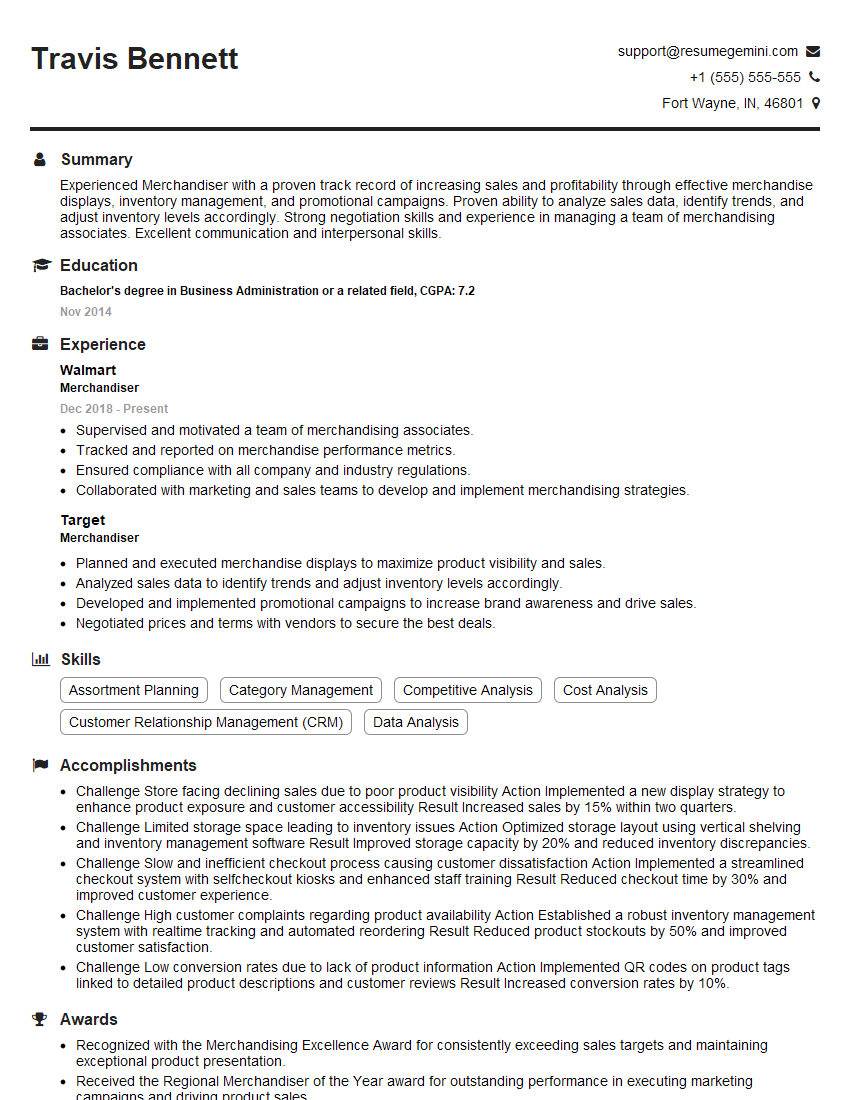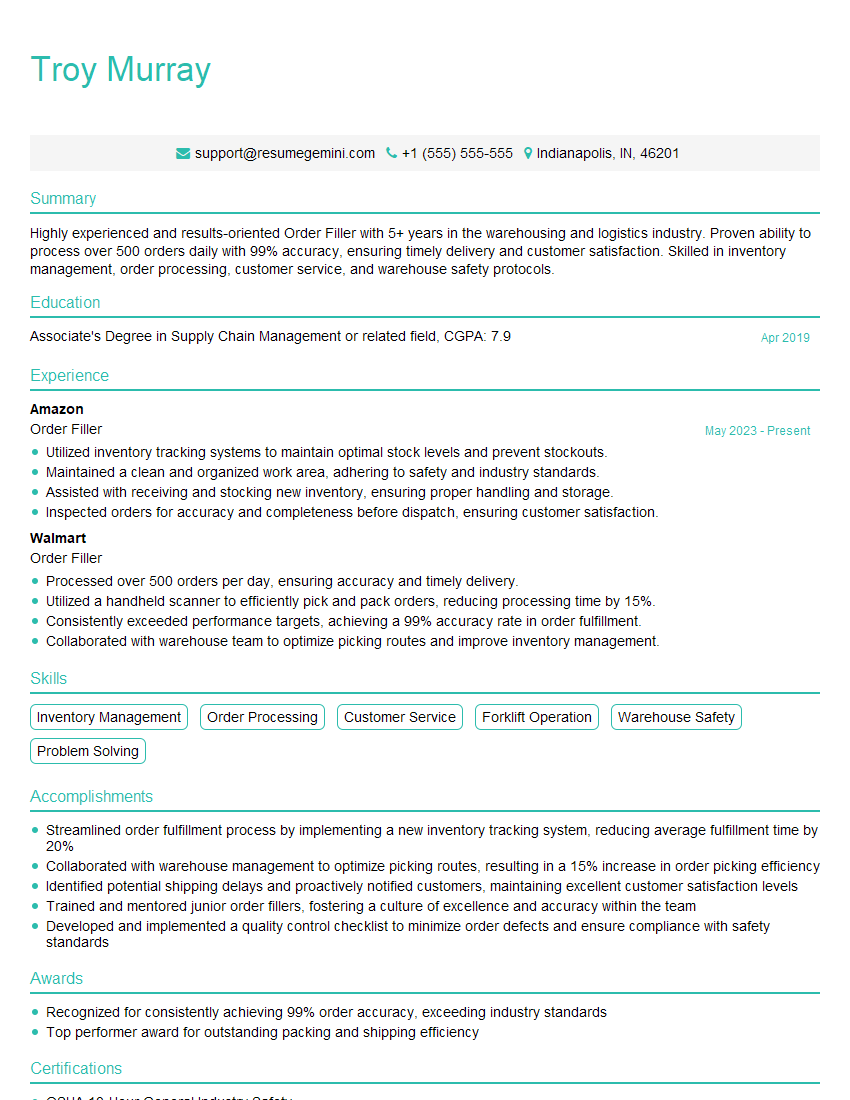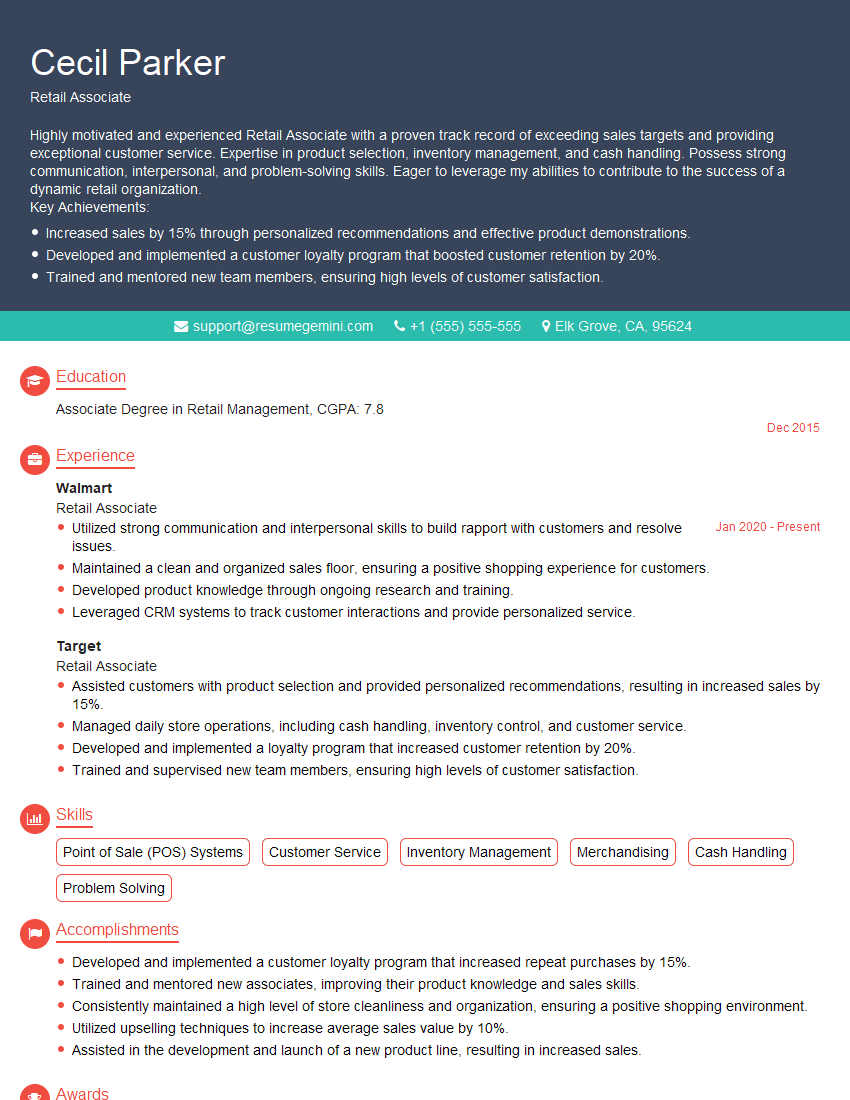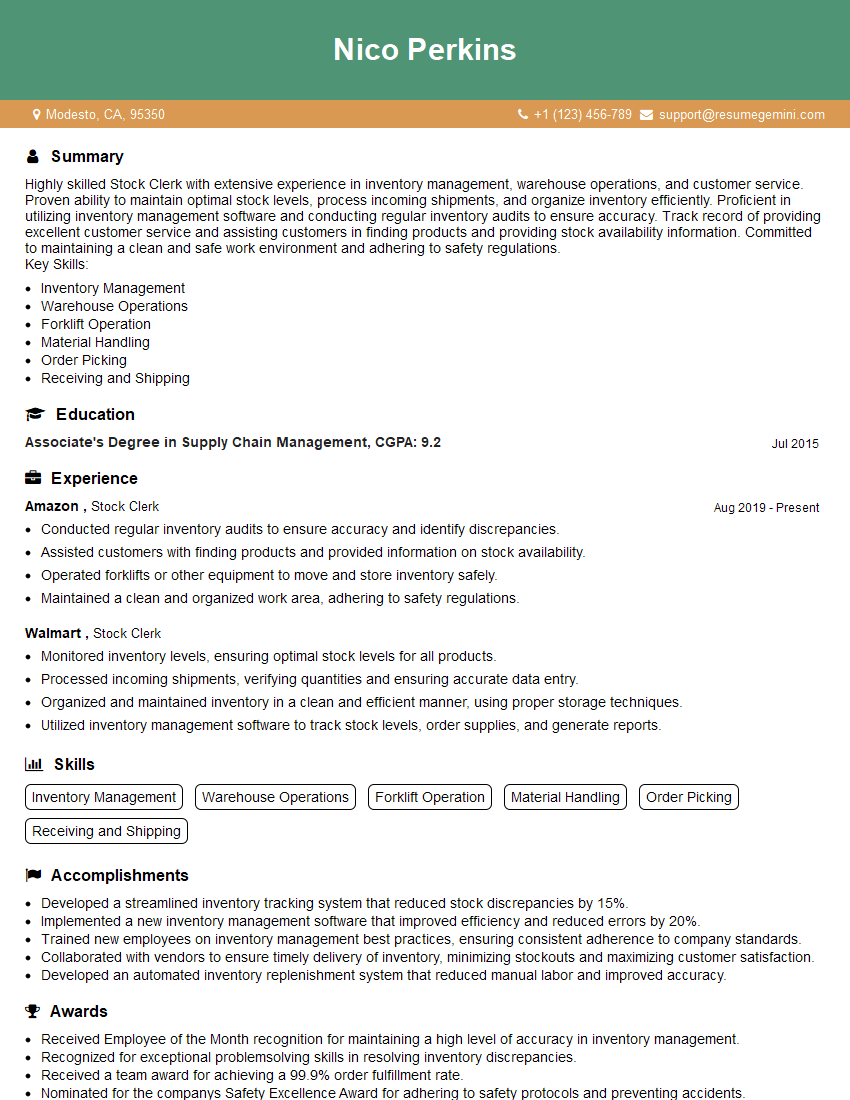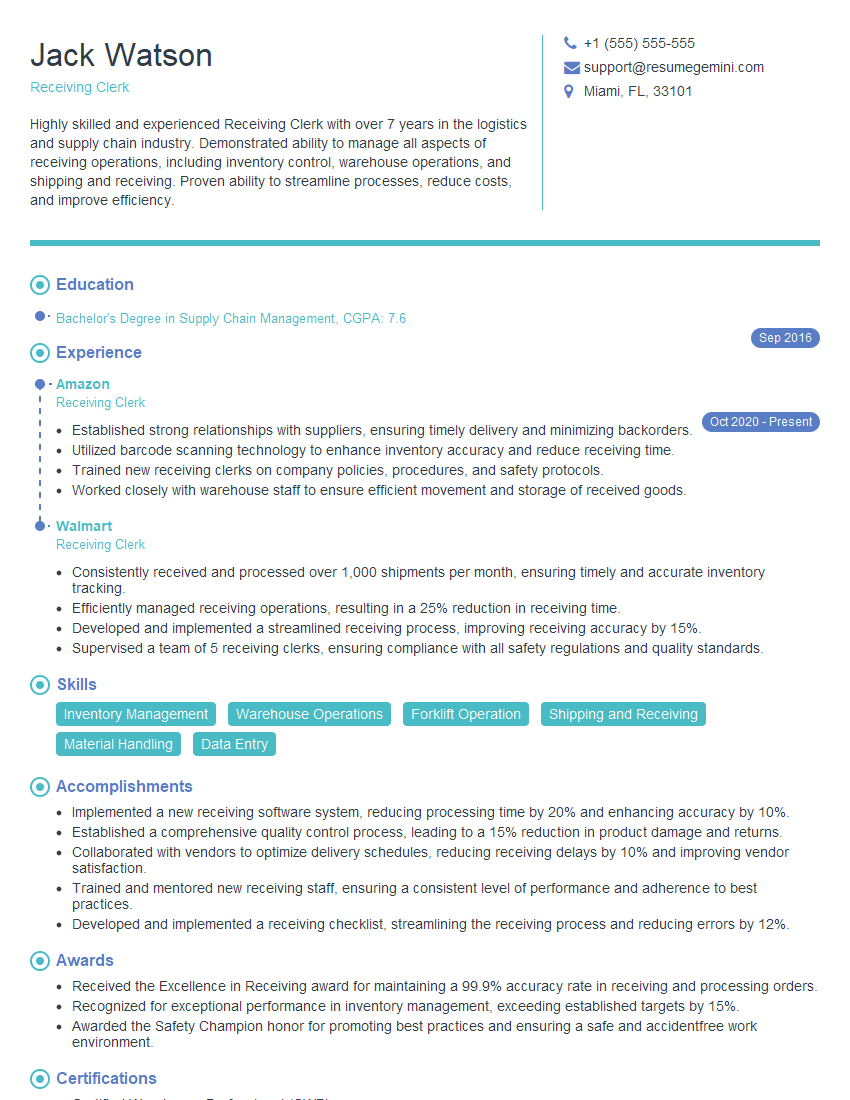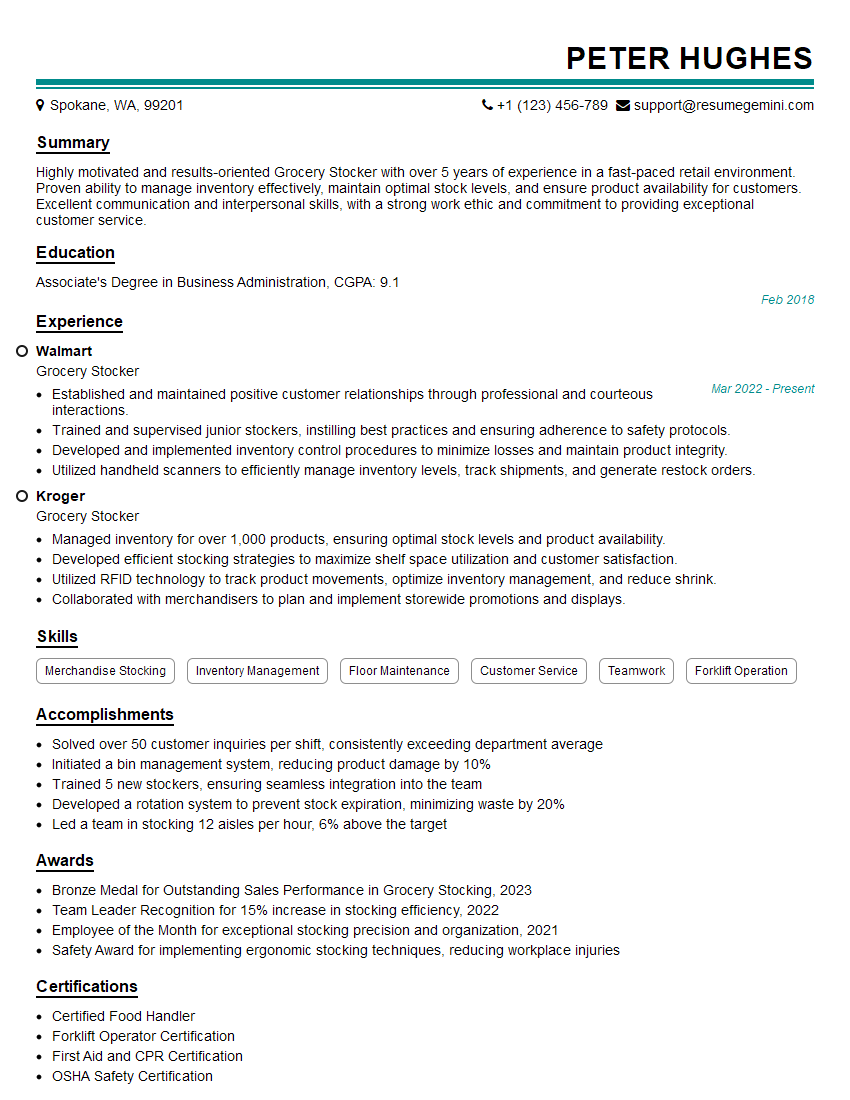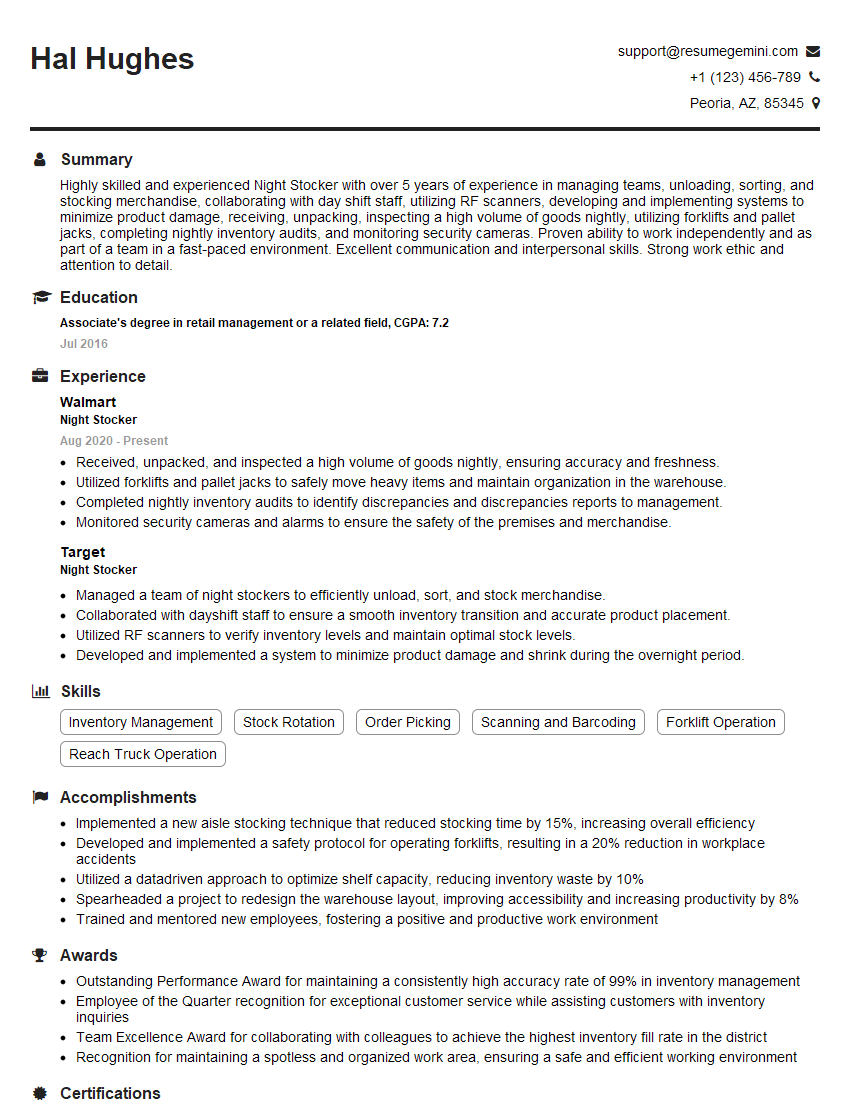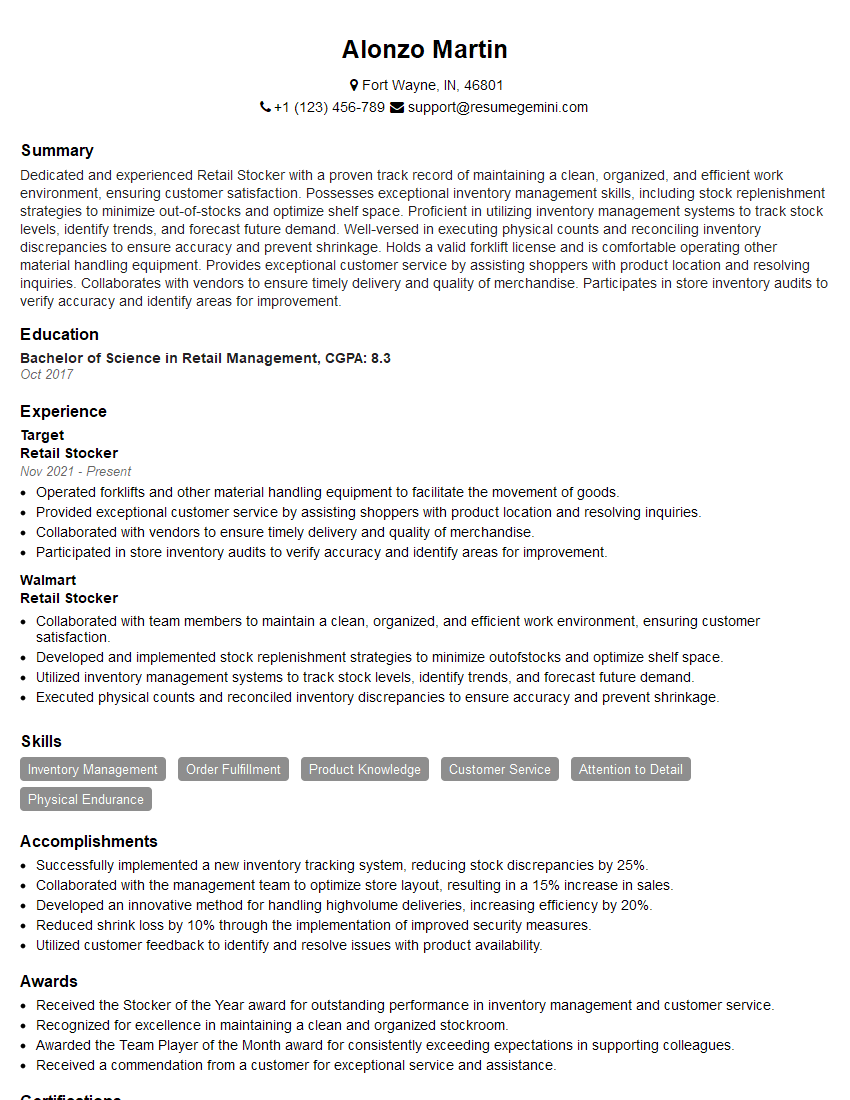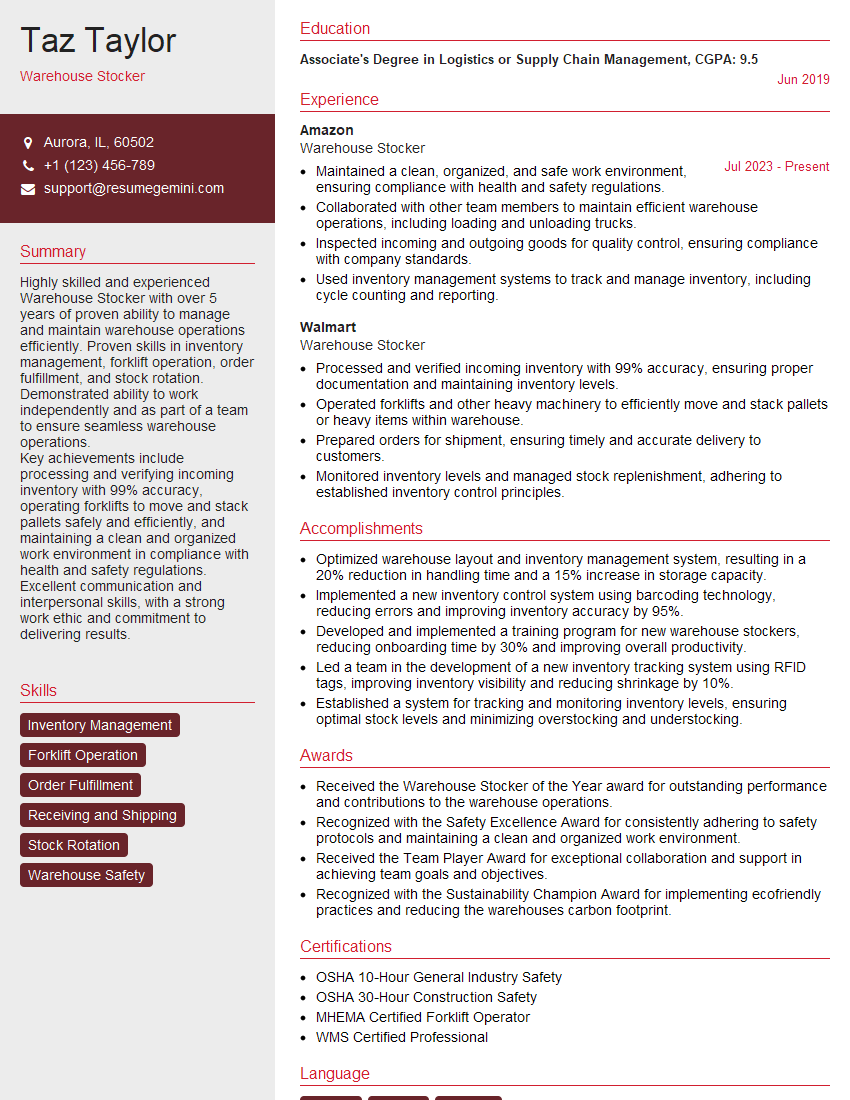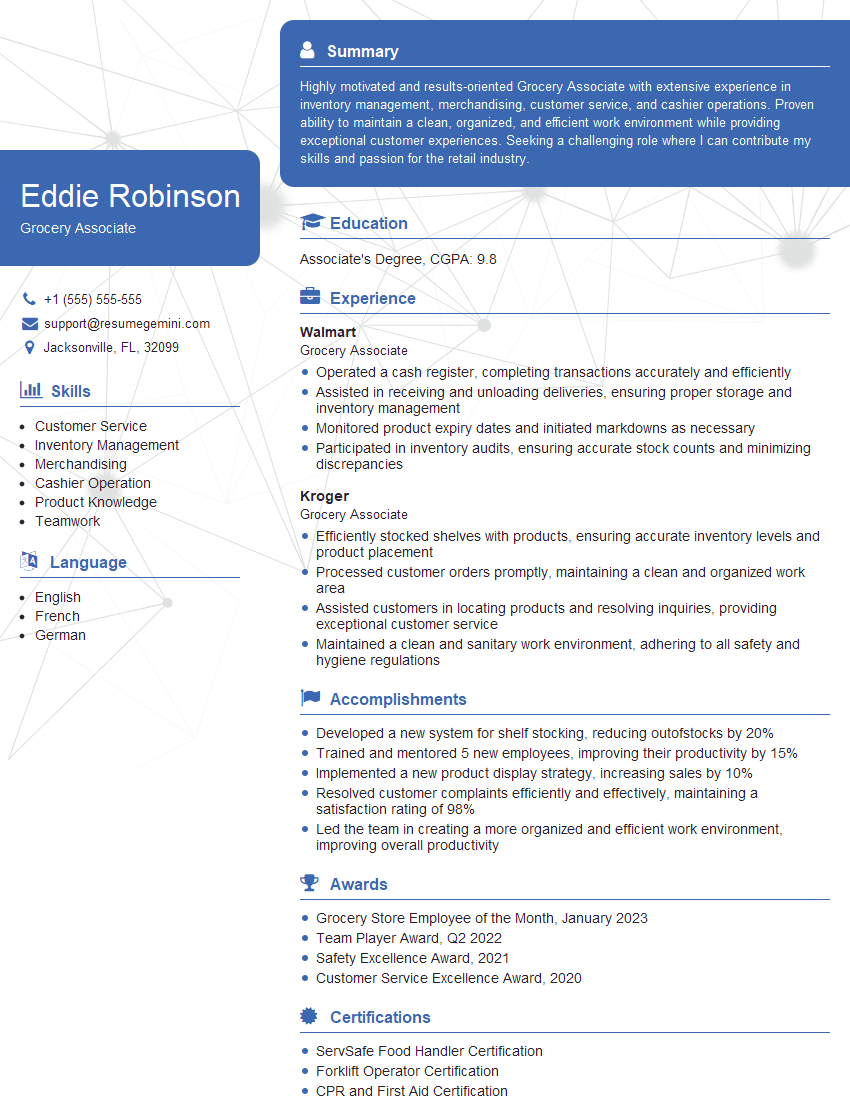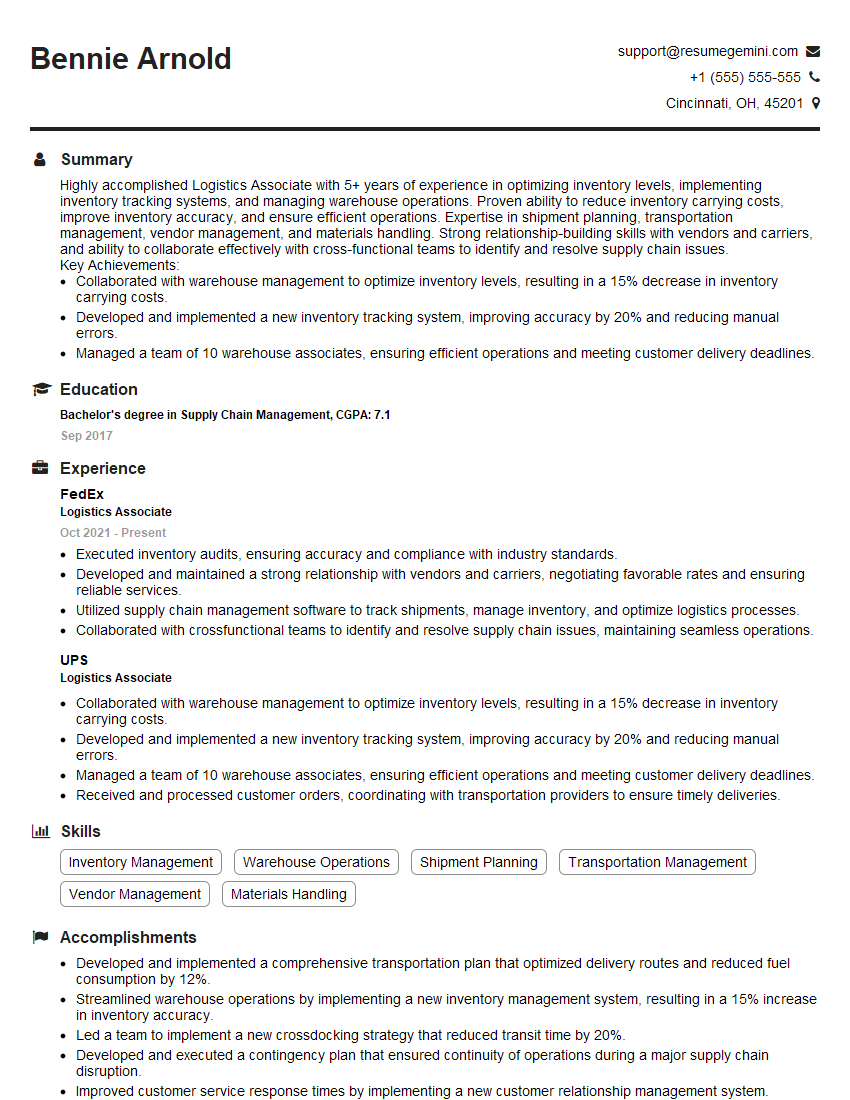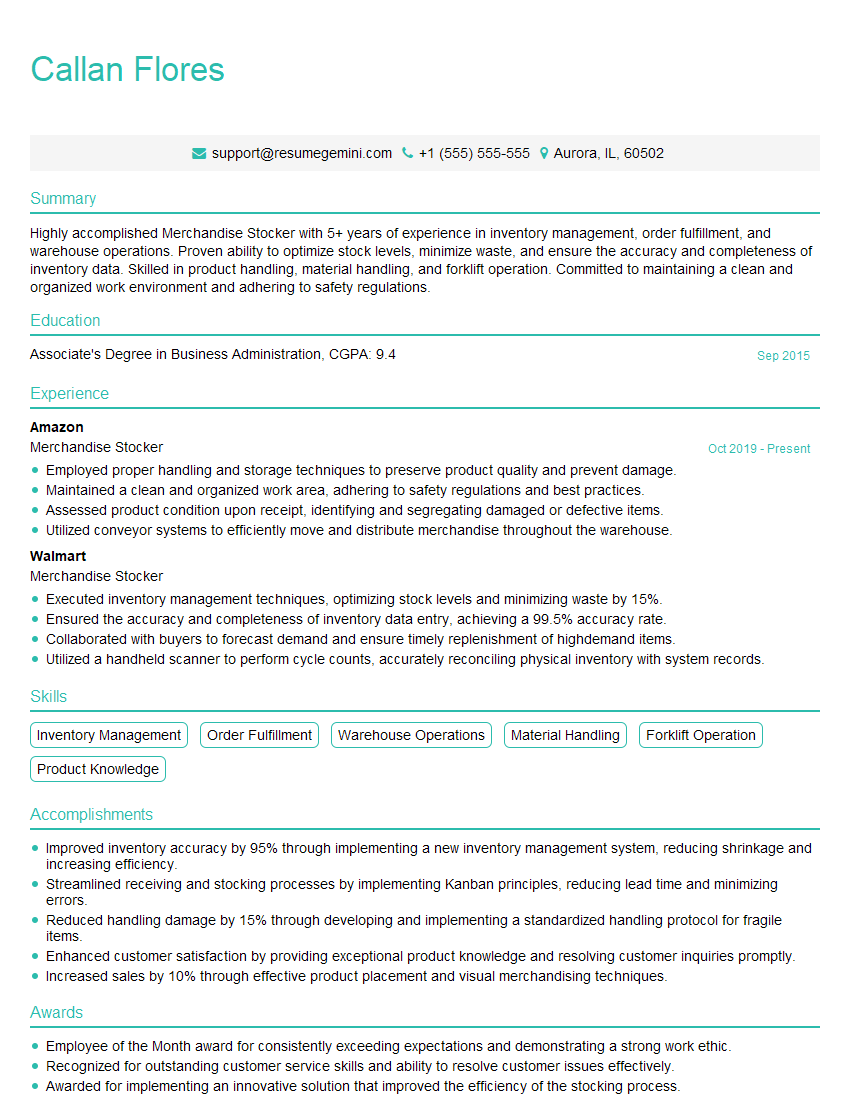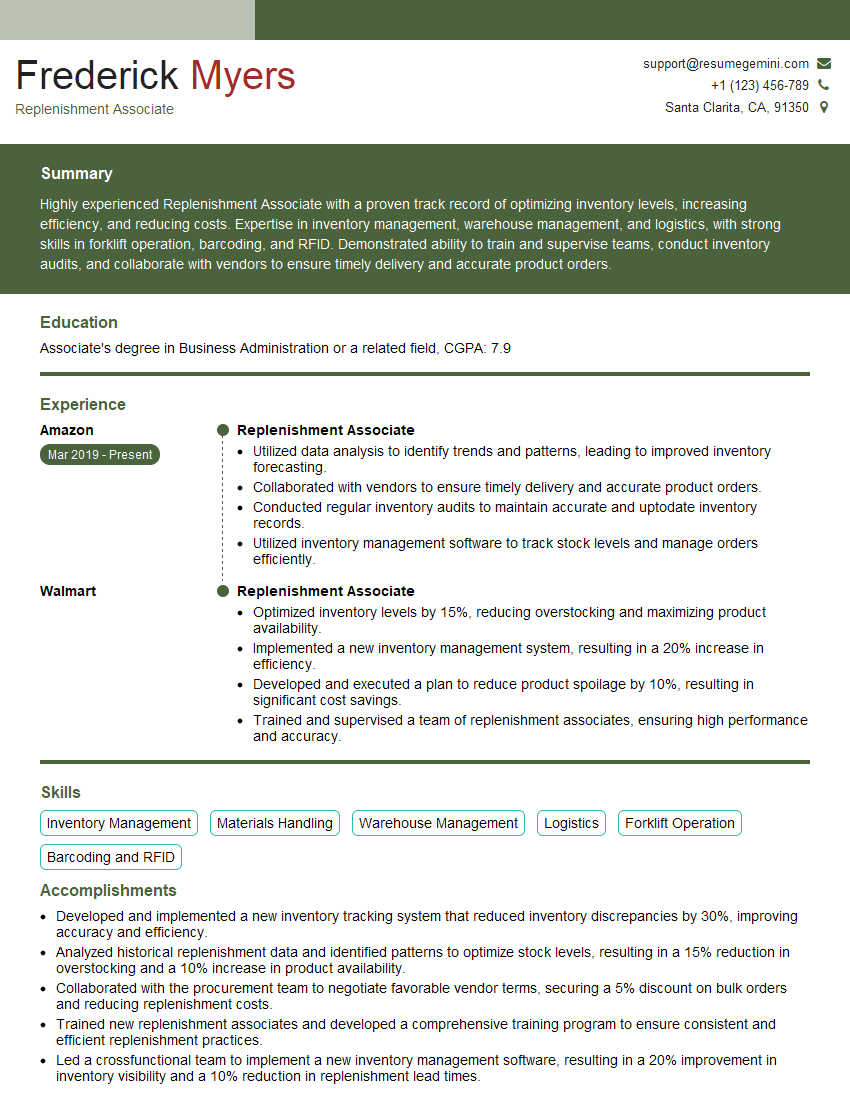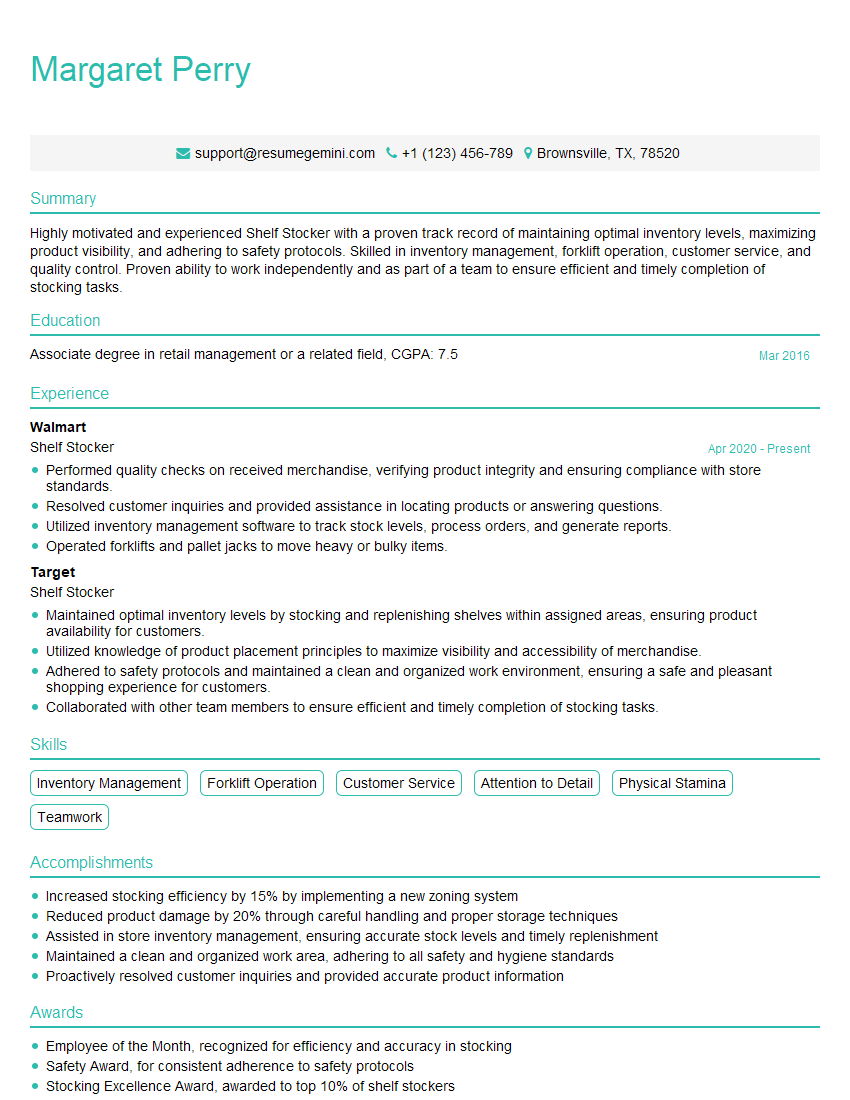Cracking a skill-specific interview, like one for Experience with stocking shelves, requires understanding the nuances of the role. In this blog, we present the questions you’re most likely to encounter, along with insights into how to answer them effectively. Let’s ensure you’re ready to make a strong impression.
Questions Asked in Experience with stocking shelves Interview
Q 1. Describe your experience with stocking shelves efficiently.
Efficient shelf stocking isn’t just about filling shelves; it’s about optimizing workflow and minimizing wasted time. My approach involves a methodical process. I begin by surveying the shelves to identify gaps and low-stock items. Then, I prioritize based on urgency and product location, starting with high-demand items or those nearing empty. I use a cart or hand truck to transport stock efficiently, keeping commonly needed items close at hand. I also strategically group similar products to reduce travel time within the aisles. Finally, I utilize the “first in, first out” (FIFO) method, ensuring older products are sold before newer ones. For example, in a grocery setting, I would ensure that milk with the earliest expiration date is placed at the front of the shelf.
Q 2. How do you prioritize tasks when stocking shelves with multiple products?
Prioritizing tasks when stocking shelves with diverse products requires a multi-faceted approach. I prioritize based on several key factors: urgency (e.g., impending expiration dates, highly demanded items), location (e.g., items needing to be placed at eye level for better visibility), and product type (e.g., prioritizing perishable goods over non-perishable goods). I often use a checklist or inventory list provided by the store’s management system to stay organized. Imagine a scenario where you have both bread and canned goods to stock. I would prioritize the bread due to its shorter shelf life, ensuring that it gets to its designated shelf space quickly.
Q 3. What methods do you use to ensure accurate product placement on shelves?
Accurate product placement is paramount for customer satisfaction and efficient inventory management. I use several methods to achieve this. First, I carefully read the product labels and compare them to the shelf labels or planograms (visual diagrams showing product placement). Second, I verify product facing (ensuring the front of the package faces outwards) and orientation (ensuring products are displayed correctly). Third, I cross-reference my work against the store’s inventory system. For example, if the inventory system indicates that a specific item should be on shelf 3, row 4, position 2, I meticulously place it exactly there. Inconsistent placement leads to out-of-stocks and difficulty finding items for both customers and staff.
Q 4. How do you handle damaged or expired products while stocking shelves?
Handling damaged or expired products requires immediate action to prevent losses and maintain store standards. I immediately remove any damaged goods from my cart and place them in designated areas according to store policy. Expired items are immediately removed and disposed of following proper procedures. This might involve marking them with a specific label or placing them in a designated disposal bin. I also report damaged or expired products to my supervisor to initiate appropriate adjustments in the inventory system. This minimizes the risk of customers purchasing unsuitable products and ensures that the store maintains its high standards for quality and safety.
Q 5. Explain your experience with using inventory management systems.
My experience with inventory management systems is extensive. I’m proficient in using systems to track stock levels, identify low-stock items, and confirm the accuracy of product placement. I’ve utilized both handheld scanners and computer-based systems to update inventory in real-time. For instance, I’m comfortable using systems that generate reports on inventory turnover, helping the store predict demands and avoid overstocking or stockouts. This means I can readily identify and address potential issues proactively.
Q 6. How do you maintain shelf organization and visual appeal?
Maintaining shelf organization and visual appeal is crucial for a positive customer experience. I ensure products are neatly arranged, facing outwards, and properly labeled. I avoid overcrowding shelves and maintain sufficient space between items. I also incorporate visual merchandising techniques, like creating eye-catching displays or grouping products thematically. For example, I might group seasonal items together or create a display that highlights a specific product promotion. Cleanliness is essential, so I regularly wipe down shelves to ensure they’re free of dust or spills. A well-organized and visually appealing shelf increases sales and creates a positive shopping experience.
Q 7. What is your experience with facing and rotating products?
Facing and rotating products are critical practices to maintain freshness and maximize sales. Facing involves ensuring that the most visually appealing and recently stocked products are at the front of the shelf. Rotating products (using the FIFO method) ensures that older products are sold before newer ones, preventing spoilage and waste. I regularly check expiration dates and move older products to the front of the shelf for quicker sale. This ensures we maintain the highest quality for our customers while minimizing waste. I regularly review what products sell best and make changes in my rotation strategy accordingly.
Q 8. How do you ensure product safety and prevent accidents while stocking shelves?
Product safety is paramount when stocking shelves. My approach is multi-faceted, focusing on preventing accidents before they happen. First, I always follow the company’s safety protocols, which include wearing appropriate footwear and using lifting aids for heavy items.
Secondly, I meticulously check for damaged or expired products, removing them from circulation immediately and reporting them according to established procedures. This prevents customers from purchasing unsafe goods. For example, if I find a dented can of soup, I’ll immediately remove it from the shelf and place it in a designated area for damaged goods, ensuring it doesn’t accidentally get restocked.
Thirdly, I ensure proper stacking and placement of products to avoid creating unstable displays. I avoid overloading shelves, leaving adequate space between boxes and ensuring nothing is precariously balanced. Think of it like building a stable tower of blocks; each layer must be secure to prevent the whole thing from collapsing.
Finally, I’m always vigilant about keeping walkways clear and free from obstructions, preventing trips and falls. A clean and organized shelving area is a safe shelving area.
Q 9. Describe your experience with heavy lifting and physical demands of stocking shelves.
Stocking shelves demands significant physical stamina and proper lifting techniques. Over my years of experience, I’ve mastered safe lifting procedures to protect my back and avoid injury. I regularly lift boxes ranging from 10 lbs to 50 lbs and occasionally heavier items with the assistance of appropriate equipment like pallet jacks or hand trucks.
I prioritize using proper body mechanics, bending at the knees and lifting with my legs, not my back. I also know when to ask for help, especially with particularly bulky or heavy items to prevent strain or injury. It’s crucial to pace oneself to avoid fatigue, especially during busy periods. Regular stretching breaks are essential to prevent muscle soreness and stiffness. My experience has taught me that prioritizing proper lifting techniques is not just about efficiency, but about long-term health and job sustainability.
Q 10. How do you handle discrepancies between inventory and shelf stock?
Discrepancies between inventory records and actual shelf stock happen frequently, and addressing them efficiently is crucial for maintaining accurate inventory and preventing stockouts. My approach involves a systematic process.
- Verification: I meticulously recount the items on the shelf, comparing the physical count to the inventory system’s record.
- Investigation: If a discrepancy exists, I carefully examine the surrounding area for misplaced items or damaged goods. Sometimes, items get accidentally knocked off the shelf or are hidden behind others.
- Reporting: I clearly document the discrepancies, detailing the product, the quantity difference, and any possible explanations (damaged goods, misplacement, etc.).
- Adjustment: Based on the company protocol, I may adjust the inventory records to reflect the actual shelf stock. Sometimes, a manager needs to be involved, particularly for larger discrepancies or for complex situations that require more in-depth investigation.
For example, if the inventory says there are 20 boxes of cereal but I only find 18, I’ll note this discrepancy, check for hidden or damaged boxes and then report it. This ensures accurate record-keeping, helps identify potential inventory control issues, and ultimately avoids stockouts or overstocking.
Q 11. How do you work effectively as part of a team during busy stocking periods?
Teamwork is essential during busy stocking periods. I excel at collaborating effectively with colleagues to ensure swift and efficient stock replenishment. My approach involves clear communication, task delegation, and mutual support.
We often divide tasks based on individual strengths and the urgency of needs. For example, one team member might focus on unloading the delivery truck while others concentrate on stocking specific sections. I’m comfortable taking the lead when necessary and equally willing to assist my teammates. I’ve also learned that open communication regarding inventory status or challenges prevents bottlenecks and ensures a smoother workflow. Think of it as a well-oiled machine; each component plays a crucial role for optimal performance.
Q 12. What is your approach to dealing with out-of-stock situations?
Handling out-of-stock situations is critical for maintaining customer satisfaction. My immediate response is to assess the extent of the stockout. If it’s a minor issue, I’ll immediately notify the appropriate personnel and prioritize restocking that product. If it’s a major stockout impacting several high-demand products, I’ll escalate the situation to management to initiate a more comprehensive response, such as arranging for expedited delivery or creating temporary signage to inform customers about the delay.
I also try to minimize disruption to the flow of operations, ensuring other shelves remain fully stocked. Communicating the out-of-stock situation clearly to customers (if necessary) and providing alternative suggestions if possible will help maintain a positive shopping experience. Proper communication and efficient prioritization are vital for quickly resolving out-of-stock issues and maintaining a smooth shopping experience for customers.
Q 13. How do you manage your time effectively to meet deadlines for stocking shelves?
Effective time management is essential for meeting stocking deadlines. My approach involves prioritizing tasks based on urgency and importance. I typically start with high-demand items and then work my way through the less urgent ones. I utilize checklists to ensure that I’ve completed all necessary tasks and to maintain a structured workflow.
I also break down larger tasks into smaller, more manageable ones. For example, instead of just thinking, ‘stock aisle 3,’ I break it down into, ‘unload boxes from the pallet, check for damaged goods, organize items by expiration date, then neatly place them on shelves.’ This approach ensures focused attention and prevents feeling overwhelmed. Continuous monitoring of my progress keeps me on track and allows me to adjust my approach as needed to meet deadlines. Proactive planning and a focus on efficiency are critical for meeting stocking deadlines, especially during peak periods.
Q 14. Describe your experience with utilizing scanners or other inventory technology.
I have extensive experience using barcode scanners and handheld inventory devices. I am proficient in using these technologies to quickly and accurately scan items, update inventory records, and identify discrepancies between the physical stock and the inventory system. This technology significantly improves efficiency and accuracy during the stocking process. I understand how to troubleshoot minor technical issues with these devices, and I can adapt to different inventory management systems with ease.
For example, if a scanner malfunctions, I understand how to report the problem to the appropriate personnel and how to continue working manually until it’s fixed. I’m familiar with various software interfaces for inventory management, ensuring seamless data entry and accurate record-keeping. My proficiency in using inventory technology has consistently enhanced my productivity and accuracy as a stockperson.
Q 15. How do you adapt to changing product locations or shelving layouts?
Adapting to changes in product locations or shelving layouts is crucial for efficiency and customer satisfaction. My approach involves a combination of proactive learning and efficient execution.
- Pre-Shift Briefing: I always start my shift by reviewing any changes communicated by management, perhaps through a daily email or whiteboard updates. This allows me to mentally map out my stocking route and anticipate potential challenges.
- Visual Aids: If provided, I rely heavily on diagrams or schematics of the new layout. These are invaluable in quickly familiarizing myself with the new locations.
- Mentorship: If I am unsure about a new location, I’m not afraid to ask a colleague for assistance. It’s always better to clarify than to misplace product.
- Trial and Error (with caution): Initially, it might take a little extra time to navigate a new setup. I embrace this learning curve, but always prioritize accuracy to prevent stock issues and customer confusion.
For example, during a recent store remodel, I quickly learned the new locations for our canned goods section by using the provided layout diagram and making a mental note of where items were moved to. Within a day, I was stocking efficiently within the new layout.
Career Expert Tips:
- Ace those interviews! Prepare effectively by reviewing the Top 50 Most Common Interview Questions on ResumeGemini.
- Navigate your job search with confidence! Explore a wide range of Career Tips on ResumeGemini. Learn about common challenges and recommendations to overcome them.
- Craft the perfect resume! Master the Art of Resume Writing with ResumeGemini’s guide. Showcase your unique qualifications and achievements effectively.
- Don’t miss out on holiday savings! Build your dream resume with ResumeGemini’s ATS optimized templates.
Q 16. How do you handle customer inquiries or interruptions while stocking?
Customer service is paramount, even while stocking. My strategy is to handle interruptions professionally and efficiently, minimizing disruption to my workflow.
- Prioritize Immediate Needs: If a customer has a question or requires assistance, I will always stop to assist them. A brief, helpful interaction maintains a positive shopping experience.
- Quick and Concise Responses: I strive to answer questions promptly and accurately. If I don’t know the answer, I will find a colleague who does.
- Point and Direct: If the customer’s request is simple (e.g., locating a product), I’ll efficiently direct them to its location and then resume stocking.
- Offer Assistance Later: If the interruption is more extensive, I might politely suggest finishing my current task and then return to assist them.
For instance, I once helped a customer find a specific spice while stocking the baking aisle. I quickly located it for them, reassured them about its location, and then resumed my stocking duties. The slight interruption didn’t significantly affect my overall productivity.
Q 17. How do you ensure adherence to company safety regulations while stocking?
Safety is my top priority. I strictly adhere to all company safety regulations, which includes proper lifting techniques, the use of safety equipment, and maintaining a clean and organized work area.
- Proper Lifting: I always use proper lifting techniques, bending at the knees and lifting with my legs, to prevent back injuries. This includes using carts and dollies when necessary to avoid overexertion.
- Safety Gear: I consistently wear appropriate safety equipment, such as gloves and safety shoes, to prevent injury.
- Awareness of Surroundings: I maintain constant awareness of my surroundings to avoid collisions with other employees, customers, or equipment. This includes paying attention to wet floors and potentially hazardous items.
- Reporting Hazards: I report any potential hazards to management immediately, such as spilled liquids or damaged shelving.
For example, I recently noticed a loose floor tile and immediately reported it to my supervisor to prevent accidents. My adherence to safety procedures helps ensure a safe working environment for myself and others.
Q 18. What is your experience with using pallet jacks or other material handling equipment?
I possess significant experience operating pallet jacks and other material handling equipment. This includes safe operation, maintenance, and awareness of safety protocols.
- Pallet Jack Operation: I am proficient in using pallet jacks to safely transport large quantities of merchandise from the stockroom to the shelves. This includes proper loading and unloading techniques.
- Equipment Inspection: Before using any equipment, I always inspect it for any damage or malfunctions. If anything seems amiss, I will report it to management immediately.
- Safety Precautions: I am mindful of safety precautions, such as maintaining proper distances from other employees and avoiding sharp turns or sudden stops while operating equipment.
- Other Equipment: My experience extends to other equipment like hand trucks and dollies, allowing me to efficiently handle a wide variety of tasks.
In my previous role, I regularly used a pallet jack to move large pallets of bottled water from the loading dock to the designated shelves. My proficiency in operating this equipment enabled me to maintain a high level of efficiency without compromising safety.
Q 19. How do you deal with slow-moving or obsolete products?
Dealing with slow-moving or obsolete products requires a strategic approach to prevent stock buildup and maintain an efficient inventory.
- Identification: I regularly check for slow-moving items based on inventory reports or visual cues (e.g., excessive stock on the shelf).
- Pricing Strategies: I’m familiar with strategies such as markdowns or promotional displays to move slow-moving items.
- Removal: I follow established procedures for removing obsolete products from the shelves. This usually involves notifying management for appropriate disposal or return procedures.
- Stock Rotation: FIFO (First In, First Out) is a crucial practice for preventing product expiration or obsolescence, which I always follow meticulously.
For example, I recently noticed that a particular brand of canned soup wasn’t selling well. I notified my manager, and we implemented a price reduction that significantly improved sales.
Q 20. How familiar are you with different types of shelving units and their capacities?
I am familiar with a variety of shelving units and their capacities, including gondola shelving, shelving for specific product types (e.g., refrigerated sections), and warehouse-style racking.
- Gondola Shelving: I understand the different configurations and load-bearing capacities of gondola shelving, ensuring proper product placement and weight distribution.
- Specialty Shelving: I am aware of specialized shelving units for specific products, such as refrigerated display cases or hanging racks for clothing.
- Weight Limits: I know the weight limits for each type of shelving and ensure that products are placed appropriately to avoid overloading and potential damage.
- Efficient Stocking: My understanding of shelving capacities helps me to optimize stocking strategies, maximizing shelf space and preventing product damage.
For example, I understand that the refrigerated shelving has a lower weight capacity than the standard gondola shelving, so I am careful to distribute heavier items on the lower shelves in the refrigerated section.
Q 21. Describe your experience with maintaining a clean and organized stocking area.
Maintaining a clean and organized stocking area is essential for both safety and efficiency. My approach involves consistent effort and attention to detail.
- Regular Cleaning: I regularly sweep and clean the floor, removing debris and spills to prevent accidents.
- Organized Shelving: I consistently ensure that shelves are neatly stocked, with products facing forward and properly labeled.
- Waste Disposal: I properly dispose of trash and cardboard according to company guidelines.
- Damage Reporting: I report any damaged shelving or products to management immediately for repair or replacement.
I believe a clean and organized work environment boosts productivity and helps maintain a positive shopping experience for customers. In my previous role, I was frequently complimented on the neatness and organization of my stocking area.
Q 22. What is your experience with receiving and processing incoming shipments?
Receiving and processing incoming shipments is a crucial first step in maintaining optimal stock levels. It involves several key stages: verifying the shipment against the purchase order for accuracy (checking quantities and product codes), inspecting for damage, and efficiently moving the goods to their designated storage areas. I’m experienced in using inventory management systems to record the receipt and update stock levels. For example, at my previous role at ‘Supermart,’ we used a handheld scanner to register each item as it arrived, which instantly updated our inventory database. This prevented discrepancies and ensured accurate stock counts.
My process involves a systematic approach; I always start by checking the packing slip against the purchase order, ensuring there are no missing items or discrepancies. Then I visually inspect the packaging for any signs of damage. After this, I carefully unload the shipment and organize it for easy access during the stocking process. Finally, I update the inventory system and inform my supervisor of any issues or discrepancies.
Q 23. How do you handle spills or messes while stocking?
Handling spills or messes is paramount for maintaining a safe and clean environment. My immediate response is to prioritize safety – clearing the area to prevent accidents. Then, I’d use appropriate cleaning supplies, which vary depending on the substance spilled (e.g., a different solution for a juice spill versus a chemical spill). After cleaning, I’d inform my supervisor to make sure the situation is documented and prevent future occurrences. For example, during a busy afternoon at ‘Fresh Foods,’ a jar of pickles fell, breaking and creating a sticky mess. I immediately cordoned off the area, grabbed cleaning supplies, and efficiently cleaned the spill while alerting my manager to help reorganize the surrounding shelves.
Q 24. Describe a time you resolved a stocking-related problem efficiently.
During a major holiday rush at ‘Quick Stop,’ we experienced an unexpected surge in demand for a specific candy, resulting in it quickly selling out. Our usual stocking schedule couldn’t keep up. I noticed the pattern and proactively suggested a temporary adjustment to our stocking strategy. Instead of the usual end-of-day restock, we implemented a mid-day restock specifically for that candy, utilizing stock from our reserve storage area. This quick, decisive action prevented lost sales and kept customers satisfied. The solution demonstrated my ability to identify problems, think critically, and implement effective solutions swiftly in a high-pressure environment.
Q 25. What is your experience working in fast-paced retail or warehouse environments?
I thrive in fast-paced retail and warehouse environments. My previous roles at ‘Supermart’ and ‘Fresh Foods’ involved managing large volumes of stock under strict time constraints, especially during peak hours and holiday seasons. I’m comfortable working efficiently under pressure, adapting quickly to changes in priorities, and coordinating with colleagues to meet deadlines. Working in these fast-paced settings has honed my organizational skills, efficiency, and ability to multitask effectively.
Q 26. What safety measures do you take to avoid injuries?
Safety is my top priority. I always follow established safety protocols, including wearing appropriate footwear (closed-toe shoes) and using safety gloves when handling heavy or sharp items. I lift heavy boxes using proper lifting techniques to avoid back injuries, ensuring I bend my knees and lift with my legs. I also regularly check for hazards, like spills, loose items, and obstructions, reporting these to my supervisor. Proactive safety awareness prevents accidents, protects myself and my colleagues, and maintains a safe work environment.
Q 27. How do you ensure proper stock rotation to minimize waste?
Proper stock rotation, also known as FIFO (First-In, First-Out), is essential for minimizing waste and maintaining product freshness. I consistently apply this method, ensuring older products are placed in front and used before newer ones. This is particularly crucial for perishable goods. For example, at ‘Fresh Foods,’ I always placed the older cartons of milk at the front of the dairy cooler, ensuring that they were sold before their expiration dates. This not only prevented waste, but also maintained product quality and helped prevent losses.
Q 28. What are your strengths and weaknesses in relation to stocking shelves?
My greatest strength is my efficiency and organizational skills; I can quickly and accurately stock shelves while maintaining an organized and visually appealing display. I’m also adaptable and quick to learn new systems and procedures. A potential weakness is that I sometimes focus so much on speed and efficiency that I occasionally overlook minor details. However, I’m actively working to improve this by implementing more thorough checklists and double-checking my work. My goal is to maintain a balance between speed and accuracy.
Key Topics to Learn for Experience with Stocking Shelves Interview
- Understanding Product Placement: Learn the principles of efficient shelf stocking, including facing, straightening, and rotating products to maximize visibility and minimize waste. Consider the impact of product placement on customer experience and sales.
- Safety and Efficiency Techniques: Explore safe lifting and carrying techniques to prevent injuries. Discuss strategies for maximizing stocking speed while maintaining accuracy and order. Think about how to minimize disruption to shoppers.
- Inventory Management and Organization: Understand how stocking contributes to accurate inventory counts. Discuss your experience with managing stock levels, identifying discrepancies, and reporting issues. Consider strategies for efficient organization within the storage space.
- Teamwork and Collaboration: Highlight your ability to work effectively with colleagues, communicate effectively, and contribute to a positive team environment. Discuss instances where you collaborated to achieve stocking goals efficiently.
- Problem-Solving and Adaptability: Showcase your ability to handle unexpected challenges, such as damaged goods, out-of-stock items, or changing store layouts. Discuss how you adapt your approach to different situations and prioritize tasks.
- Customer Service within Stocking: Consider how your actions while stocking impact customers. Reflect on instances where you helped customers find products or maintained a clean and accessible shopping environment.
Next Steps
Mastering the art of stocking shelves demonstrates valuable skills like organization, efficiency, attention to detail, and teamwork – all highly transferable to various roles. A strong resume highlighting these skills is crucial for attracting potential employers. To increase your chances of getting noticed by Applicant Tracking Systems (ATS), create an ATS-friendly resume that showcases your abilities effectively. ResumeGemini is a trusted resource to help you build a professional and impactful resume. We provide examples of resumes tailored to “Experience with stocking shelves” to help guide you. Invest time in crafting a compelling resume; it’s your first impression on a potential employer.
Explore more articles
Users Rating of Our Blogs
Share Your Experience
We value your feedback! Please rate our content and share your thoughts (optional).
What Readers Say About Our Blog
good
